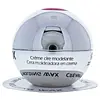What's inside
What's inside
 Benefits
Benefits

 Concerns
Concerns

 Ingredients Side-by-side
Ingredients Side-by-side

Water
Skin ConditioningRhus Verniciflua Peel Cera
EmollientVp/Va Copolymer
Stearic Acid
CleansingPalmitic Acid
EmollientCopernicia Cerifera Wax
Cetyl Ethylhexanoate
EmollientSteareth-21
CleansingSteareth-2
EmulsifyingPropylene Glycol
HumectantParfum
MaskingPhenoxyethanol
PreservativeAminomethyl Propanol
BufferingCarbomer
Emulsion StabilisingTropolone
Skin ConditioningCI 19140
Cosmetic ColorantCI 15985
Cosmetic ColorantWater
Skin ConditioningBis-Diglyceryl Polyacyladipate-2
EmollientCera Alba
EmollientPetrolatum
EmollientCetearyl Alcohol
EmollientPropylene Glycol
HumectantVp/Va Copolymer
Diethylhexyl Maleate
EmollientCopernicia Cerifera Wax
Ozokerite
Emulsion StabilisingVinyl Caprolactam/Vp/Dimethylaminoethyl Methacrylate Copolymer
Skin ConditioningPEG-40 Hydrogenated Castor Oil
EmulsifyingParfum
MaskingPEG-90m
Emulsion StabilisingCitric Acid
BufferingPhenoxyethanol
PreservativeGlycerin
HumectantMethylparaben
PreservativePropylparaben
PreservativeButylparaben
MaskingEthylparaben
PreservativeWater, Bis-Diglyceryl Polyacyladipate-2, Cera Alba, Petrolatum, Cetearyl Alcohol, Propylene Glycol, Vp/Va Copolymer, Diethylhexyl Maleate, Copernicia Cerifera Wax, Ozokerite, Vinyl Caprolactam/Vp/Dimethylaminoethyl Methacrylate Copolymer, PEG-40 Hydrogenated Castor Oil, Parfum, PEG-90m, Citric Acid, Phenoxyethanol, Glycerin, Methylparaben, Propylparaben, Butylparaben, Ethylparaben
Ingredients Explained
These ingredients are found in both products.
Ingredients higher up in an ingredient list are typically present in a larger amount.
Copernicia Cerifera Wax comes from a palm tree native to Brazil; another name for this ingredient is Carnauba Wax.
This ingredient is used to thicken texture and also leaves behind a film when applied.
Fun fact: This wax has the highest melting point of all natural waxes and low solubility.
Learn more about Copernicia Cerifera WaxParfum is a catch-all term for an ingredient or more that is used to give a scent to products.
Also called "fragrance", this ingredient can be a blend of hundreds of chemicals or plant oils. This means every product with "fragrance" or "parfum" in the ingredients list is a different mixture.
For instance, Habanolide is a proprietary trade name for a specific aroma chemical. When used as a fragrance ingredient in cosmetics, most aroma chemicals fall under the broad labeling category of “FRAGRANCE” or “PARFUM” according to EU and US regulations.
The term 'parfum' or 'fragrance' is not regulated in many countries. In many cases, it is up to the brand to define this term.
For instance, many brands choose to label themselves as "fragrance-free" because they are not using synthetic fragrances. However, their products may still contain ingredients such as essential oils that are considered a fragrance by INCI standards.
One example is Calendula flower extract. Calendula is an essential oil that still imparts a scent or 'fragrance'.
Depending on the blend, the ingredients in the mixture can cause allergies and sensitivities on the skin. Some ingredients that are known EU allergens include linalool and citronellol.
Parfum can also be used to mask or cover an unpleasant scent.
The bottom line is: not all fragrances/parfum/ingredients are created equally. If you are worried about fragrances, we recommend taking a closer look at an ingredient. And of course, we always recommend speaking with a professional.
Learn more about ParfumPhenoxyethanol is a preservative that has germicide, antimicrobial, and aromatic properties. Studies show that phenoxyethanol can prevent microbial growth. By itself, it has a scent that is similar to that of a rose.
It's often used in formulations along with Caprylyl Glycol to preserve the shelf life of products.
Propylene Glycol is an odorless, colorless liquid. As a humectant, it helps skin retain moisture. It also aids in delivering active ingredients.
Another role of this ingredient is preventing a product from melting or freezing. Propylene glycol also adds antimicrobrial properties to a product, elongating product lifespan.
This ingredient is considered an organic alcohol and commonly added into both cosmetics and foods.
Those with sensitive skin or conditions may develop a rash when using this ingredient.
Learn more about Propylene GlycolWe don't have a description for Vp/Va Copolymer yet.
Water. It's the most common cosmetic ingredient of all. You'll usually see it at the top of ingredient lists, meaning that it makes up the largest part of the product.
So why is it so popular? Water most often acts as a solvent - this means that it helps dissolve other ingredients into the formulation.
You'll also recognize water as that liquid we all need to stay alive. If you see this, drink a glass of water. Stay hydrated!
Learn more about Water